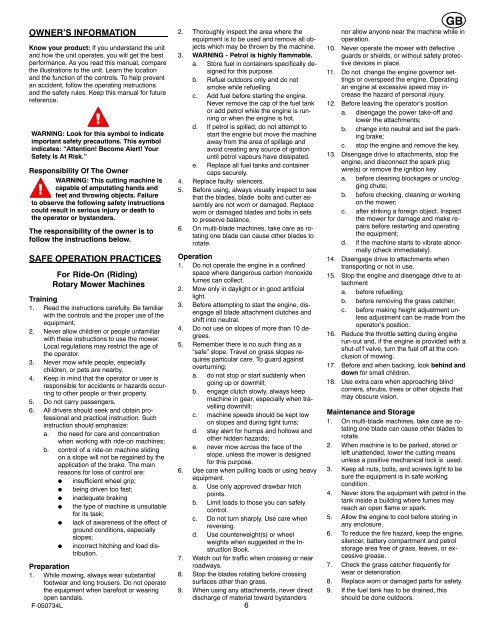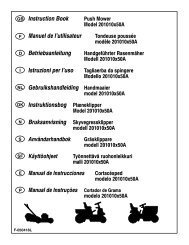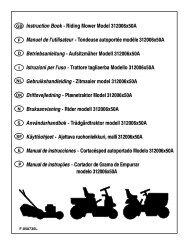Instruction Book − Riding Mower Model ... - Safe Motor AS
Instruction Book − Riding Mower Model ... - Safe Motor AS
Instruction Book − Riding Mower Model ... - Safe Motor AS
You also want an ePaper? Increase the reach of your titles
YUMPU automatically turns print PDFs into web optimized ePapers that Google loves.
OWNER’S INFORMATION<br />
Know your product: If you understand the unit<br />
and how the unit operates, you will get the best<br />
performance. As you read this manual, compare<br />
the illustrations to the unit. Learn the location<br />
and the function of the controls. To help prevent<br />
an accident, follow the operating instructions<br />
and the safety rules. Keep this manual for future<br />
reference.<br />
WARNING: Look for this symbol to indicate<br />
important safety precautions. This symbol<br />
indicates: “Attention! Become Alert! Your<br />
<strong>Safe</strong>ty Is At Risk.”<br />
Responsibility Of The Owner<br />
WARNING: This cutting machine is<br />
capable of amputating hands and<br />
feet and throwing objects. Failure<br />
to observe the following safety instructions<br />
could result in serious injury or death to<br />
the operator or bystanders.<br />
The responsibility of the owner is to<br />
follow the instructions below.<br />
SAFE OPERATION PRACTICES<br />
For Ride-On (<strong>Riding</strong>)<br />
Rotary <strong>Mower</strong> Machines<br />
Training<br />
1. Read the instructions carefully. Be familiar<br />
with the controls and the proper use of the<br />
equipment.<br />
2. Never allow children or people unfamiliar<br />
with these instructions to use the mower.<br />
Local regulations may restrict the age of<br />
the operator.<br />
3. Never mow while people, especially<br />
children, or pets are nearby.<br />
4. Keep in mind that the operator or user is<br />
responsible for accidents or hazards occurring<br />
to other people or their property.<br />
5. Do not carry passengers.<br />
6. All drivers should seek and obtain professional<br />
and practical instruction. Such<br />
instruction should emphasize:<br />
a. the need for care and concentration<br />
when working with ride-on machines;<br />
b. control of a ride-on machine sliding<br />
on a slope will not be regained by the<br />
application of the brake. The main<br />
reasons for loss of control are:<br />
insufficient wheel grip;<br />
being driven too fast;<br />
inadequate braking<br />
the type of machine is unsuitable<br />
for its task;<br />
lack of awareness of the effect of<br />
ground conditions, especially<br />
slopes;<br />
incorrect hitching and load distribution.<br />
Preparation<br />
1. While mowing, always wear substantial<br />
footwear and long trousers. Do not operate<br />
the equipment when barefoot or wearing<br />
open sandals.<br />
F-050734L<br />
2. Thoroughly inspect the area where the<br />
equipment is to be used and remove all objects<br />
which may be thrown by the machine.<br />
3. WARNING - Petrol is highly flammable.<br />
a. Store fuel in containers specifically designed<br />
for this purpose.<br />
b. Refuel outdoors only and do not<br />
smoke while refuelling.<br />
c. Add fuel before starting the engine.<br />
Never remove the cap of the fuel tank<br />
or add petrol while the engine is running<br />
or when the engine is hot.<br />
d. If petrol is spilled, do not attempt to<br />
start the engine but move the machine<br />
away from the area of spillage and<br />
avoid creating any source of ignition<br />
until petrol vapours have dissipated.<br />
e. Replace all fuel tanks and container<br />
caps securely.<br />
4. Replace faulty silencers.<br />
5. Before using, always visually inspect to see<br />
that the blades, blade bolts and cutter assembly<br />
are not worn or damaged. Replace<br />
worn or damaged blades and bolts in sets<br />
to preserve balance.<br />
6. On multi-blade machines, take care as rotating<br />
one blade can cause other blades to<br />
rotate.<br />
Operation<br />
1. Do not operate the engine in a confined<br />
space where dangerous carbon monoxide<br />
fumes can collect.<br />
2. Mow only in daylight or in good artificial<br />
light.<br />
3. Before attempting to start the engine, disengage<br />
all blade attachment clutches and<br />
shift into neutral.<br />
4. Do not use on slopes of more than 10 degrees.<br />
5. Remember there is no such thing as a<br />
“safe” slope. Travel on grass slopes requires<br />
particular care. To guard against<br />
overturning:<br />
a. do not stop or start suddenly when<br />
going up or downhill;<br />
b. engage clutch slowly, always keep<br />
machine in gear, especially when travelling<br />
downhill;<br />
c. machine speeds should be kept low<br />
on slopes and during tight turns;<br />
d. stay alert for humps and hollows and<br />
other hidden hazards;<br />
e. never mow across the face of the<br />
slope, unless the mower is designed<br />
for this purpose.<br />
6. Use care when pulling loads or using heavy<br />
equipment.<br />
a. Use only approved drawbar hitch<br />
points.<br />
b. Limit loads to those you can safely<br />
control.<br />
c. Do not turn sharply. Use care when<br />
reversing.<br />
d. Use counterweight(s) or wheel<br />
weights when suggested in the <strong>Instruction</strong><br />
<strong>Book</strong>.<br />
7. Watch out for traffic when crossing or near<br />
roadways.<br />
8. Stop the blades rotating before crossing<br />
surfaces other than grass.<br />
9. When using any attachments, never direct<br />
discharge of material toward bystanders<br />
6<br />
GB<br />
nor allow anyone near the machine while in<br />
operation.<br />
10. Never operate the mower with defective<br />
guards or shields, or without safety protective<br />
devices in place.<br />
11. Do not change the engine governor settings<br />
or overspeed the engine. Operating<br />
an engine at excessive speed may increase<br />
the hazard of personal injury.<br />
12. Before leaving the operator’s position<br />
a. disengage the power take-off and<br />
lower the attachments;<br />
b. change into neutral and set the parking<br />
brake;<br />
c. stop the engine and remove the key.<br />
13. Disengage drive to attachments, stop the<br />
engine, and disconnect the spark plug<br />
wire(s) or remove the ignition key<br />
a. before cleaning blockages or unclogging<br />
chute;<br />
b. before checking, cleaning or working<br />
on the mower;<br />
c. after striking a foreign object. Inspect<br />
the mower for damage and make repairs<br />
before restarting and operating<br />
the equipment;<br />
d. if the machine starts to vibrate abnormally<br />
(check immediately).<br />
14. Disengage drive to attachments when<br />
transporting or not in use.<br />
15. Stop the engine and disengage drive to attachment<br />
a. before refuelling;<br />
b. before removing the grass catcher;<br />
c. before making height adjustment unless<br />
adjustment can be made from the<br />
operator’s position.<br />
16. Reduce the throttle setting during engine<br />
run-out and, if the engine is provided with a<br />
shut-of f valve, turn the fuel off at the conclusion<br />
of mowing.<br />
17. Before and when backing, look behind and<br />
down for small children.<br />
18. Use extra care when approaching blind<br />
corners, shrubs, trees or other objects that<br />
may obscure vision.<br />
Maintenance and Storage<br />
1. On multi-blade machines, take care as rotating<br />
one blade can cause other blades to<br />
rotate.<br />
2. When machine is to be parked, stored or<br />
left unattended, lower the cutting means<br />
unless a positive mechanical lock is used.<br />
3. Keep all nuts, bolts, and screws tight to be<br />
sure the equipment is in safe working<br />
condition.<br />
4. Never store the equipment with petrol in the<br />
tank inside a building where fumes may<br />
reach an open flame or spark.<br />
5. Allow the engine to cool before storing in<br />
any enclosure.<br />
6. To reduce the fire hazard, keep the engine,<br />
silencer, battery compartment and petrol<br />
storage area free of grass, leaves, or excessive<br />
grease.<br />
7. Check the grass catcher frequently for<br />
wear or deterioration.<br />
8. Replace worn or damaged parts for safety.<br />
9. If the fuel tank has to be drained, this<br />
should be done outdoors.





